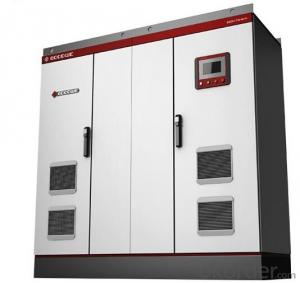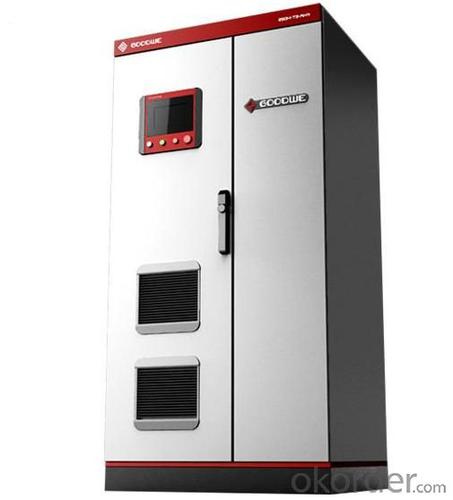12V Solar Inverter GW500K-MTL On Grid Solar Inverter
OKorder Service Pledge
OKorder Financial Service
You Might Also Like
Central solar inverter GW500K-MTL solar inverter is widely used in large-scale solar power plants. As core equipment in solar power station, its stability and reliability play an important role in long-term investment returns. GW500K-MTL solar inverter adopts industrial design philosophy as well as proven inverter control technology, which ensures its 25 years life time. In terms of solar plants grid integration, GoodWe solar inverter is also equipped with output power liner control, SVG reactive power compensation technology, LVRT capability and other advanced technologies which are apt to grid integration and management. In addition, its lower THDi output and higher conversion efficiency provide stronger support to green and efficient power plants operation.
Datasheet

- Q: Can a solar inverter be used with a solar-powered air conditioner?
- Yes, a solar inverter can be used with a solar-powered air conditioner. The solar inverter is responsible for converting the direct current (DC) produced by the solar panels into alternating current (AC) that can be used to power electrical appliances, including air conditioners. By connecting the solar inverter to the solar panels and then to the solar-powered air conditioner, the AC produced by the inverter can be utilized to run the air conditioner, effectively making it solar-powered.
- Q: Can a solar inverter be used in areas with high levels of electromagnetic interference (EMI)?
- Yes, a solar inverter can be used in areas with high levels of electromagnetic interference (EMI) as long as it is properly shielded and designed to withstand such conditions. However, it is important to choose an inverter that meets the necessary EMI compliance standards to ensure reliable and efficient operation in these environments.
- Q: Can a solar inverter be used with different types of solar panels (monocrystalline, polycrystalline, thin-film)?
- Yes, a solar inverter can be used with different types of solar panels such as monocrystalline, polycrystalline, and thin-film. Solar inverters are designed to convert the direct current (DC) produced by solar panels into alternating current (AC) suitable for use in household or commercial electrical systems. As long as the solar panels generate DC power within the operating range of the inverter, they can be compatible regardless of the technology used.
- Q: Can a solar inverter be used with different grid voltages or frequencies?
- No, a solar inverter cannot be used with different grid voltages or frequencies. Solar inverters are designed to convert the DC power generated by solar panels into AC power that matches the specific voltage and frequency of the grid it is connected to. Using a solar inverter with different grid voltages or frequencies can result in compatibility issues and potentially damage the equipment.
- Q: Do I need a special inverter for a battery storage system?
- Yes, a special inverter is required for a battery storage system. Unlike traditional solar inverters that convert DC power from solar panels into AC power for immediate use or for feeding back into the grid, a battery storage system inverter is designed to manage the charging and discharging of the batteries. It ensures that the stored energy is used efficiently and safely, and allows for backup power during grid outages.
- Q: Can a solar inverter be used in regions with extreme weather conditions?
- Yes, solar inverters can be used in regions with extreme weather conditions. However, the durability and performance of the inverter may vary depending on the specific weather conditions. It is important to choose a solar inverter that is designed to withstand the extreme weather conditions of the region, such as high temperatures, strong winds, heavy rain, or snow. Additionally, proper installation, regular maintenance, and protection from harsh weather elements can help ensure the longevity and efficient operation of the solar inverter in extreme weather conditions.
- Q: Can a solar inverter be used in commercial applications?
- Yes, a solar inverter can be used in commercial applications. Commercial buildings can install solar panels and connect them to a solar inverter, which converts the DC power generated by the panels into usable AC power for the building's electrical system. This allows commercial establishments to harness solar energy and reduce their reliance on traditional grid power sources, resulting in cost savings and environmental benefits.
- Q: Are there any noise or vibration concerns associated with solar inverters?
- Yes, there can be noise and vibration concerns associated with solar inverters, although they are generally minimal. Some older or lower-quality inverters may produce a humming or buzzing sound, especially when operating at high power levels. Vibrations can also occur due to the internal components and fans. However, modern inverters are designed to minimize noise and vibrations, and most people find them to be quiet and unobtrusive.
- Q: Can a solar inverter be used in areas with high electromagnetic radiation?
- Yes, a solar inverter can be used in areas with high electromagnetic radiation. However, it is important to note that the performance and reliability of the inverter may be affected by the presence of high electromagnetic radiation. High radiation levels can potentially cause electromagnetic interference (EMI) which may disrupt the functioning of the inverter and lead to reduced efficiency or even failure. Therefore, it is recommended to take necessary precautions such as proper grounding, shielding, and selecting inverters with robust EMI protection mechanisms when installing solar inverters in areas with high electromagnetic radiation. Additionally, it is advisable to consult with experts or manufacturers who can provide guidance on specific models of solar inverters that are designed to withstand and perform well in high electromagnetic radiation environments.
- Q: What are the advantages of using a transformerless solar inverter?
- The advantages of using a transformerless solar inverter include increased efficiency, reduced size and weight, lower cost, and improved reliability. Due to the absence of a transformer, these inverters are more energy-efficient, resulting in higher electricity production from the solar panels. They also have a smaller form factor and weigh less, making them easier to install and transport. Transformerless inverters are typically cheaper to manufacture, leading to cost savings for consumers. Additionally, their simplified design without a bulky transformer reduces the likelihood of component failure, enhancing the overall reliability of the system.
Send your message to us
12V Solar Inverter GW500K-MTL On Grid Solar Inverter
OKorder Service Pledge
OKorder Financial Service
Similar products
Hot products
Hot Searches
Related keywords

























